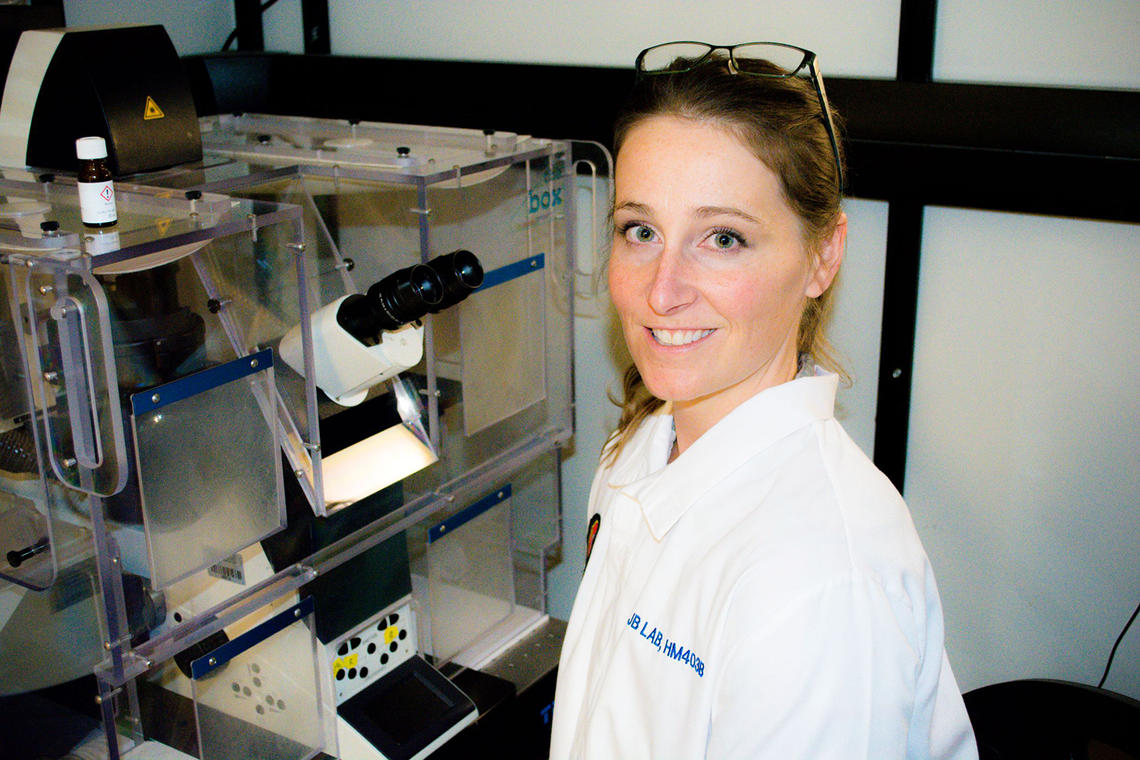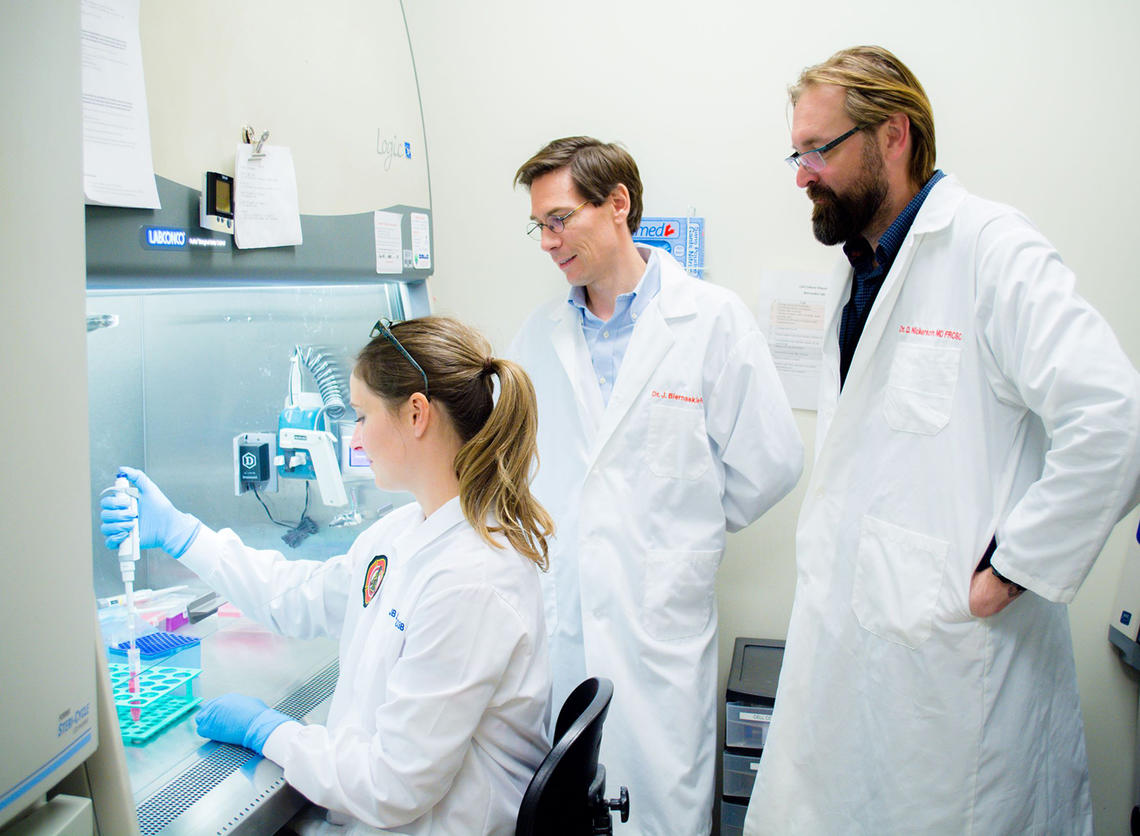Dec. 16, 2019
Stem cell study aims to improve function of skin grafts and reduce scarring and chronic itch


Holly Sparks co-authored a study into improving skin grafts using human skin cells grown in the lab.
Rahil Tarique
For people whose skin has been severely burned or damaged through injury or disease, a split thickness skin graft is the current standard of treatment. The procedure involves shaving a thin portion of the top layer of skin from a non-damaged part of a patient’s body and using it to cover the wound.
“While this is effective at closing the wound, which is vital for patients to heal and to prevent infection, the end result is often non-functional scar tissue,” says Dr. Holly Sparks, an Alberta Innovates Health Solutions Clinician-Scientist fellow, large animal veterinarian, and newly recruited assistant professor in the Faculty of Veterinary Medicine (UCVM), who co-authored a new study into improving skin grafts, published in Stem Cell Reports.
“The resulting grafted skin is dysfunctional because it is missing much of the original dermis, the middle layer of skin that harbours connective tissue, blood vessels, oil and sweat glands, nerves, and hair follicles needed for the skin’s normal structure and function.”
Growing new human skin cells in the lab
As part of the study, Sparks and a multidisciplinary team of researchers developed the techniques to isolate dermal progenitor cells from a small biopsy of adult human skin and grow them in culture. “We also refined an experimental model to implant the cultured cells underneath a skin graft in the laboratory to help regenerate new, more functional, dermis within the graft.”

Holly Sparks, Jeff Biernaskie, and Vincent Gabriel were part of a multidisciplinary team.
Rahil Tarique
“Some of the biggest challenges for patients living with skin grafts is that of chronic itch and altered mechanical function. Through this project, we were actually able to begin to successfully address those outcomes. After three months, we observed that the transplanted cultured cells integrated into the skin graft, the severity of itch was reduced, and the mechanical function was returned more toward that of uninjured skin, which is really exciting,” says Sparks.
Talking to human patients beneficial to veterinary medicine as well
Sparks, who is an equine surgeon, found the study beneficial to her understanding of what patients – both horse and human – experience after traumatic burns or skin injury.
“For me as a veterinarian, my patients don't talk, so I need to infer a lot about their experience with various injuries through their behaviour. Throughout this study, I was able to learn directly from human patients and their medical team about their experience and the key features of living with skin grafts that were the most challenging for them,” says Sparks.
“That was really eye-opening for me and made me think about my own research in a different way.
I think across all health research disciplines, we owe it to our patients to constantly endeavour to tailor our experimental goals to directly address their key challenges and improve their quality of life.
“Certainly, anybody who sustains a deep skin wound or burn injury faces acute challenges of overcoming those injuries in the short term. But we often forget that burn survivors also have to deal with a variety of other — sometimes lifelong — impairments due to excessive scarring such as immobility, non-healing wounds due to the fragility of the skin graft, as well as pain and itch. Finding ways to limit this scar formation, by regenerating new tissue within the graft, could greatly improve their quality of life, for the rest of their lives. I think by addressing this, we can help patients in a really meaningful way.”
Collaboration between regenerative medicine researchers, veterinarians, physicians, and engineers
Sparks points out the collaborative and multidisciplinary nature of the research project was critical to its success. The team comprises basic stem cell biologists, biomedical engineers, veterinarians, and physicians specializing in burn wounds and plastic surgery. It was enabled largely through the vision of the Calgary Firefighters Burn Treatment Society, whose mandate is to bridge the gap between the laboratory and the clinic to enable better outcomes for burn survivors.
“After three months, the cells don’t appear to exhibit any worrisome behaviours such as uncontrolled growth or wandering outside the graft,” says Dr. Jeff Biernaskie, PhD, who is senior author of the study and holds the Calgary Firefighters Burn Treatment Society Chair in Skin Regeneration and Wound Healing. “We also don’t see these progenitor cells generating anything except new dermal tissue, all of which is encouraging for their potential future use in the clinic.”
Jeff Biernaskie is an associate professor in the Department of Comparative Biology and Experimental Medicine in the Faculty of Veterinary Medicine and the Calgary Firefighters Burn Treatment Society Chair in Skin Regeneration and Wound Healing. He has a joint appointment in the Cumming School of Medicine, and is a member of the Alberta Children’s Hospital Research Institute and the Hotchkiss Brain Institute.
Additional authors of the study were Natacha Agabalyan, Nicole Rosin, Katie Anker, Grace Yoon (UCVM); Samar Tarraf, Elena Di Martino (Schulich School of Engineering); Lindsay Burnett, Duncan Nickerson and Vincent Gabriel (Cumming School of Medicine).
The study was funded by an Alberta Innovates CRIO Team grant, the Canadian Stem Cell Network and the Calgary Firefighters Burn Treatment Society.
The Calgary Firefighters Burn Treatment Society contribution is part of the university’s ongoing fundraising campaign, Energize: The Campaign for Eyes High.




